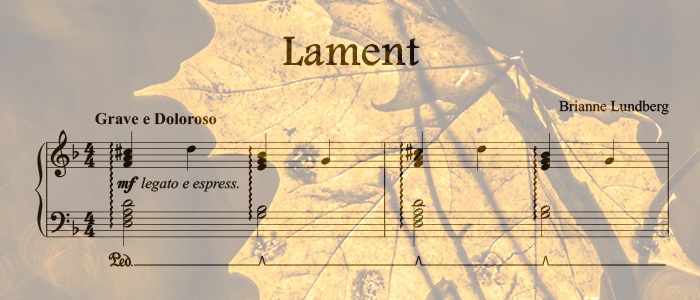Lament: An Advanced Halloween Piano Solo
Why should only little kids have something to do on Halloween?
A few years ago, I released an EP (mini album) of original Halloween piano compositions on iTunes. It has a few "Halloweeny" pieces ranging from late intermediate to advanced level, and it's always fun to break it out during the Halloween season.
Knowing that most piano students are beginner to intermediate level, I then turned my focus to composing easy Halloween sheet music. But when I started getting requests from people who wanted to learn to play the original Halloween music from my EP, I realized I'd better start transcribing!
So if you're one of those people who wants to learn more advanced Halloween piano music, this is for you!
"Lament" is a late intermediate/early advanced piano solo in D minor, which to me is one of the most melancholy minor keys for music to be written in. The music is deeply expressive with a strong classical influence. As a dramatic and expressive original composition, "Lament" is a beautiful advanced Halloween piano solo that can be deeply moving for performer and audience.
The Story Behind the Music
Every composition has a story behind it. Here is how "Lament" came to be:
I sat down at my piano, hoping to write something Halloweeny. I'd already written several playful, spooky piano pieces like Spooky Shuffle and Dracula's Waltz that were perfect for kids (or kids at heart!), so I wanted this one to have a more serious tone. I wanted it to appeal more to adults and teens. I also liked the idea of something that would give the performer plenty of opportunity for expression.
Where I live, Halloween is very much a children's holiday with heavy emphasis on trick-or-treating. But as we age, all things in life develop new meaning for us. For those of us who have lived a little longer, Halloween can take on a somber feel -- one that deals with the reality of death or loss.
I am not a fan of the horror genre, so as I sat on the piano bench I focused my thoughts on what it feels like to lose someone. The feelings of sadness, loss, darkness, grief, and heartfelt longing...ultimately, feelings of lament. I closed my eyes and let my fingers wander for a bit on the keys. When my fingers found their way to the opening chord, inspiration struck, and I knew what to play.
The music was born as though from the fingers of a pained and pitiful creature, grieving and alone, possibly not even human, perhaps playing on a timeworn, yet beautiful grand piano in a decrepit mansion on a stormy, dark night. Opening broad, rolling chords flowed naturally into a pained, heartfelt melody with arpeggiated bass accompaniment (as a lefty, I've always gravitated toward moving left hand accompaniments). Gradually, the themes continued to develop until suddenly, it took a more intense turn.
A few minutes into the piece, I paused, sensing that the music needed to grow further. This developed into a quick and fluid broken chord pattern that was almost rolling out of control, adding a sense of urgency and drama. The transition into this new theme felt to me just like how in real life, grief tends to come in waves that sometimes roll over you and other times slam into you like a tsunami. The music continued to develop further until it merged together with the opening themes into the height of mourning before finally collapsing back down as though onto a bed of silent tears of lament.
The story behind "Lament" may seem overdramatic as I try to find words for what it felt like to compose, but I make no apology. Those who have experienced grief and sorrow know that words often fail to convey the appropriate meaning. But "where words fail, music speaks" (Hans Christian Andersen). This has always been true for me, and "Lament" gave me the perfect way to express it.
Teaching Tools in "Lament" Piano Solo
Naturally, as a piano teacher, I am always looking for music that is not only beautiful to listen to but also helps one grow as a musician. For all my compositions and arrangements, I list the "teaching tools" or educational elements that the piece includes so that other teachers and students may know what they can learn from it.
Arguably, the most valuable teaching tools in "Lament" are the minor key, rubato, and expression. There is a lot of room for interpretation, which allows the pianist to explore the depth of their own musical expression. Other pedagogical aspects of the piece include rolled chords, legato, ledger lines, tempo changes, ritardando, right hand bass, left hand treble, fermata, dynamics, arpeggios, cross hands, cross-staff movement, chord inversions, octave changes, tenuto, and phrasing.
It is my hope that everyone who plays or hears "Lament" may learn something from it, whether music-related or not. After all, grief is a part of life, and music can be a powerful tool to help us process it.
I will be releasing more Halloween piano sheet music soon! In the meantime, please check out my current library of Halloween music for beginner to advanced piano.




